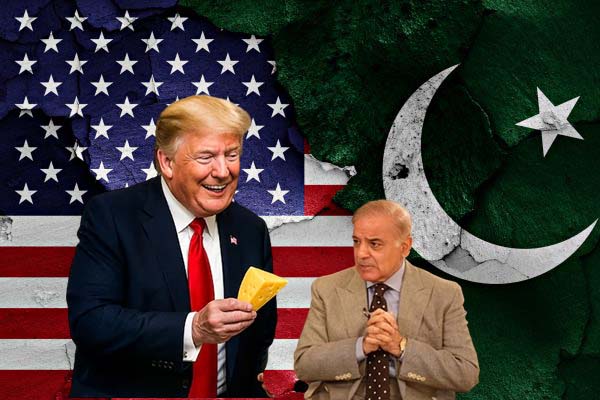
- The US and Pakistan are strengthening ties with cooperation in critical minerals, counterterrorism, and economic engagement, including a USD 500 million US investment in Pakistan’s mineral sector.
- This partnership is seen as transactional, driven by US needs for alternative mineral sources, counterterrorism support, and geopolitical balancing with India and China.
- Historically, US-Pakistan relations have been marked by short-term alliances, Cold War-era military aid, post-9/11 cooperation, and repeated phases of estrangement.
- Divergent national interests, Pakistan’s ties with China, and US relations with India prevent the development of a long-term, value-based partnership.
The relationship between the US and Pakistan is showing a new warmth. They are seeking to enhance bilateral relations and economic cooperation. On September 14, 2025, in a phone call between US Secretary of State Marco Rubio and Pakistan’s Deputy Prime Minister Ishaq Dar, they reaffirmed their commitment to further strengthen their relationship across multifaceted areas of cooperation. They are also exploring cooperation in the critical minerals sector. In that direction, recently, a US metals company signed a USD 500 million deal with Pakistan.1
From recent developments in their bilateral relationship, it appears that there is a new warmth or bonhomie between them. But while looking through a historical lens, it suggests that it is just a transactional relationship driven by American self-interests, rather than a fundamental strategic realignment. This ‘give and take’ approach in their relationship prioritises immediate and tangible benefits rather than a long-term ideological and value-based partnership.
The Transactional Drivers of the US policy
The recent developments between the US and Pakistan are not an indication of new strategic alignment. They are examples of the transactional foreign policy of the United States. This should not be considered as a relationship of conviction, but one of convenience. Reasons behind the recent development of bonhomie between Washington and Islamabad are as follows.
China is a dominating player in the rare earth elements and other strategic minerals, essential for state-of-the-art technologies, including sectors like defence, electric vehicles, and clean energy. The US is searching for alternative sources to secure its critical mineral supply chains. Here, Pakistan gives a compelling opportunity, as it holds large and untapped reserves in its territory. To exploit this opportunity, the US agreed to a USD 500 million deal with Pakistan, which should not be considered as a goodwill gesture. It is purely a business deal that aims to diversify its supply chain and reduce its dependency on China.
For counterterrorism, Islamabad’s cooperation is crucial for Washington. On August 12 2025, a counterterrorism dialogue between the US and Pakistan was organised. They discussed the issue of terrorism and underscored the importance of developing effective approaches to counter terrorism threats.2 Though in the past, Islamabad had cheated Washington in the case of counter-terrorism. But Washington believes Islamabad is still relevant in helping the US by providing intelligence and logistical support to counter the terrorist organisations such as ISIS-Khorasan and Tahreek-e-Taliban and others that pose a threat to US interests. In return, Pakistan will enjoy financial assistance and access to the US market.
It is also a geopolitical balancing act. Washington, under the Trump leadership, is uncomfortable with New Delhi’s closer relationship with Russia and, particularly, buying Russian oil. By engaging with Pakistan, the US is signalling to New Delhi that it enjoys the leverage of balancing opportunity. It signals the return of the old days when India and Pakistan were treated as hyphenated by the powers.
Why the Relationship is not Long-Term: A Historical Perspective
The ‘give and take’ approach has consistently hindered the establishment of a long-term, stable relationship between the US and Pakistan. Some past instances are mentioned below.
During the Cold War, Pakistan was considered a frontline country in the region to contain communism. Pakistan was one of the most allied countries of the USA. In turn, Pakistan was provided with military and economic aid to help modernise its armed forces and boost its economic growth. Through this, Islamabad was primarily aiming to counter India. This was a classic example of transactional partnership. Later, when the Soviet threat vanished in the late 1980s, the US distanced itself from Pakistan and imposed sanctions on Pakistan for developing a nuclear programme. This suggests that their relationship was never about shared values, but for transactional reasons.
After the 9/11 terror attack, due to its location, Pakistan once again became a very important player in America’s War on Terror. It became a key non-NATO ally in the fight against Al-Qaeda and the Taliban. For this purpose, billions of dollars of aid were given to Pakistan. However, during this period, the relationship was full of mutual suspicion and a constant sense of ‘give and take’. Washington was expecting greater outcomes from Islamabad, while Islamabad was feeling exploited. There was also a case of trust deficit between them. The discovery of Osama Bin Laden in the garrison town of Pakistan indicated that Islamabad is untrustworthy. When the US began its withdrawal from Afghanistan, the transactional foundations crumbled again, and US officials started blaming Pakistan for its ‘double game’.
The transactional relationships between Pakistan and the United States are also due to divergence in their core national interests and conflicting alliances. Here, conflicting alliances refer to an iron brotherhood relationship between Pakistan and China, and a strategic partnership between India and the United States. Those with a history of ‘double game’ prevent a sustained and robust partnership.
The history of the US-Pakistan relationship is marked by a clear pattern of estrangement after the engagement. Similarly, the recent developments are driven by immediate needs for critical minerals and geopolitical balancing. However, it should not be discounted that, for a period of time, if everything goes well, including internal political stability and control over armed rebellion in the mineral-rich region of Pakistan, it may yield benefits for both sides. An investment for Pakistan and a new source of critical minerals for the US.
References:
- https://economictimes.indiatimes.com/news/international/business/us-firm-agrees-500-million-investment-deal-with-pakistan-for-critical-minerals/articleshow/123776292.cms?from=mdr
- https://www.state.gov/releases/office-of-the-spokesperson/2025/08/joint-statement-on-u-s-pakistan-counterterrorism-dialogue
Ashish Keserwani is a PhD research scholar at Amity University Uttar Pradesh. His research focuses on the dynamics of South Asia, with a particular emphasis on great power rivalries. His work explores the complex interactions among India, Pakistan, and other regional actors, as well as China and the US. Views expressed are the author’s own.
